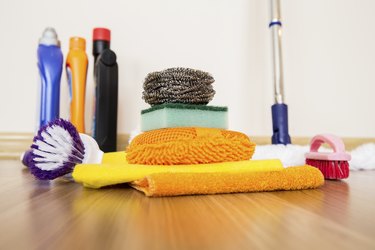
Not all powdered bleaches are created equally. Oxygen-powdered bleaches, derived from plant-based oxalic acids, and chlorine-free products offer a more environmentally friendly choice than does a calcium-based chlorine powdered bleach, or calcium hypochlorite, typically used for pool water chlorination. While you can certainly clean and disinfect with a calcium hypochlorite solution, make certain you work in a well-ventilated area and take the appropriate safety precautions.
Safety First
Video of the Day
Chlorine-based bleaching powder can deteriorate rapidly and lose its effect if left in an open container. For safety, store it in a cool, dry and dark location in a plastic, wood or ceramic container. If you live in a hot climate and do not store the chlorine-based bleach properly, its container can erupt, releasing toxic chlorine gases. Never mix powdered or liquid chlorine bleach with ammonia -- this creates an extremely harmful toxic gas. In fact, never mix drain or toilet cleaners, acids or any two different household cleaning agents together.
Video of the Day
Sanitizing Agent
After working in the garden removing diseased, dead or rotting plants, sanitize your gardening tools by cleaning them with a chlorine-based powdered bleach mixed with water. Mix a cup of the powder in roughly a quart of water to wash gardening tools; let them sun dry and rub them down with oil to prevent rust after they dry. Bleaching powder also safely cleans and sanitizes bleach-safe cottons and linens.
Household Disinfectant Spray
For a bathroom disinfectant, mix equal parts of chlorine powdered bleach in water and pour it into a spray bottle. Use it as a spray for bathroom tiles, toilets, tile floors and tubs. Let sit, then rinse off after 15 minutes. For use elsewhere in the home as a sanitizing agent, mix 1 tablespoon of bleach per quart of water in a spray bottle. Spritz it on doorknobs, children's toys or plastic furniture, countertops or other surfaces, and let dry.
Clean the Decks
An oxygen-based powdered bleach without chlorine gives you an alternative for cleaning outdoor decks. Because the cleaning solution does not harm wood fibers, plant and animal life, it makes a safe deck cleaner. It won't discolor the deck and is safe to use on any product that accepts water. Mix the solution according to the manufacturer's instructions, and scrub the deck down with a scrub brush attached to a mop or broom handle. Let it sit for 5 to 10 minutes, and rinse with a hose.
Safe Alternatives
If you're not comfortable using a chlorine-based powdered bleach, many manufacturers offer chlorine-free alternatives. Mainly used for laundry, these products do not have the same disinfecting power for sanitizing and disinfecting inside the home as chlorine mixtures. You might prefer using liquid chlorine bleach in place of powdered chlorine bleach when you need to safely disinfect, as it's safer and easier to store and costs less to buy.
- Total Environment Centre Safety Solutions: Calcium Hypochlorite
- State of Michigan: Cleaning on a Shoestring
- Ask the Builder: Oxygen Bleach Deck Cleaning
- The State of New Jersey Department of Health: Common Cleaning Products May Be Dangerous When Mixed
- The Fun Times Guide: Oxygen Bleach vs Chlorine Bleach: See Why Products Like OxiClean Are Best